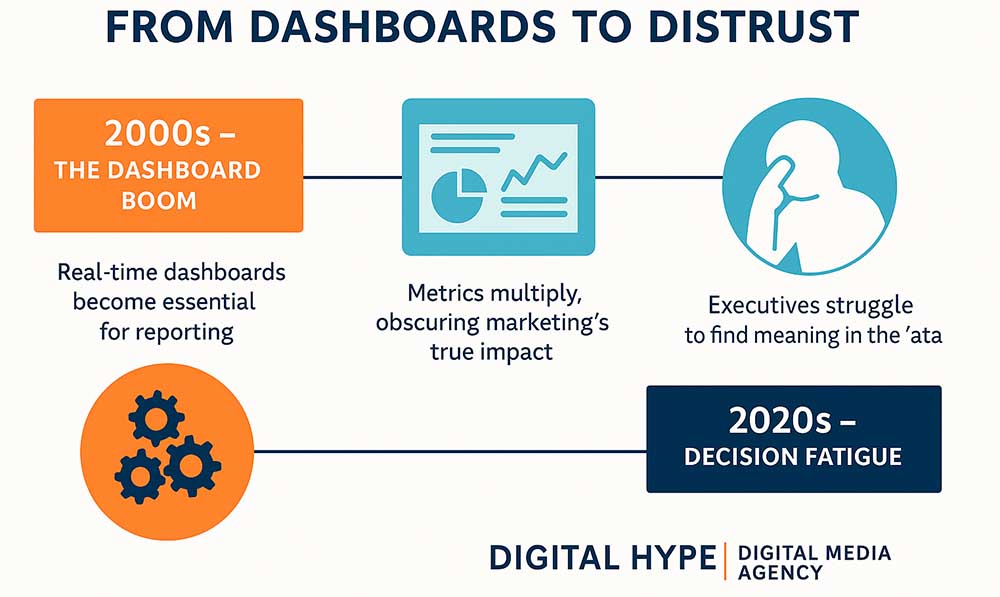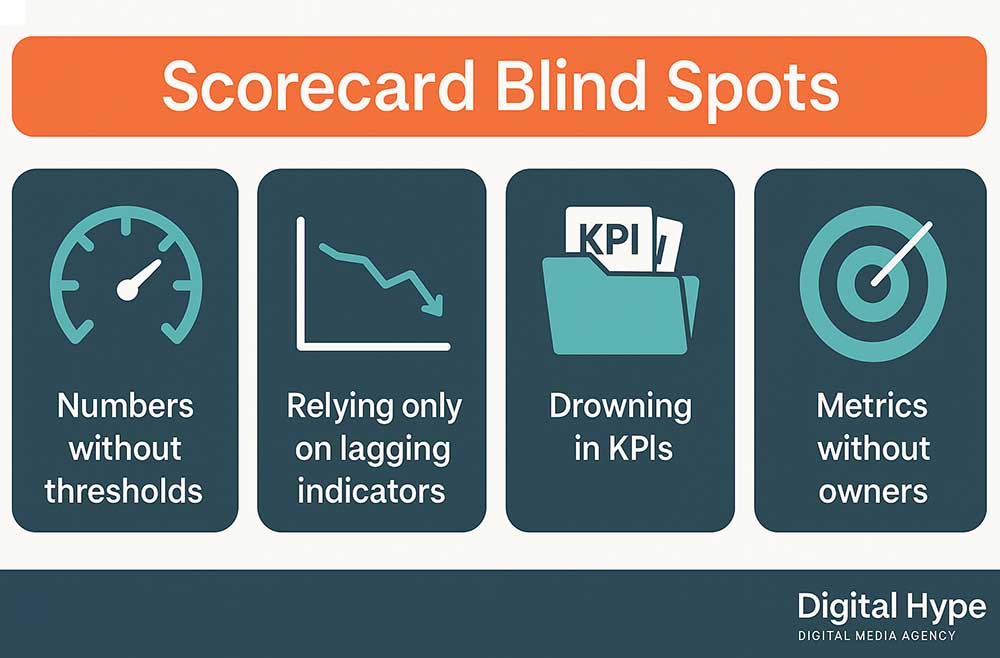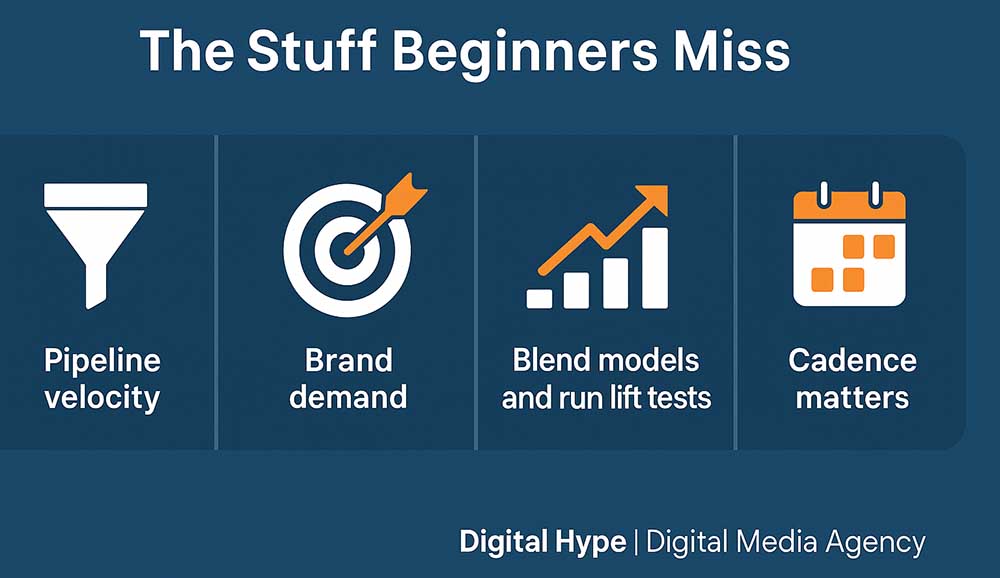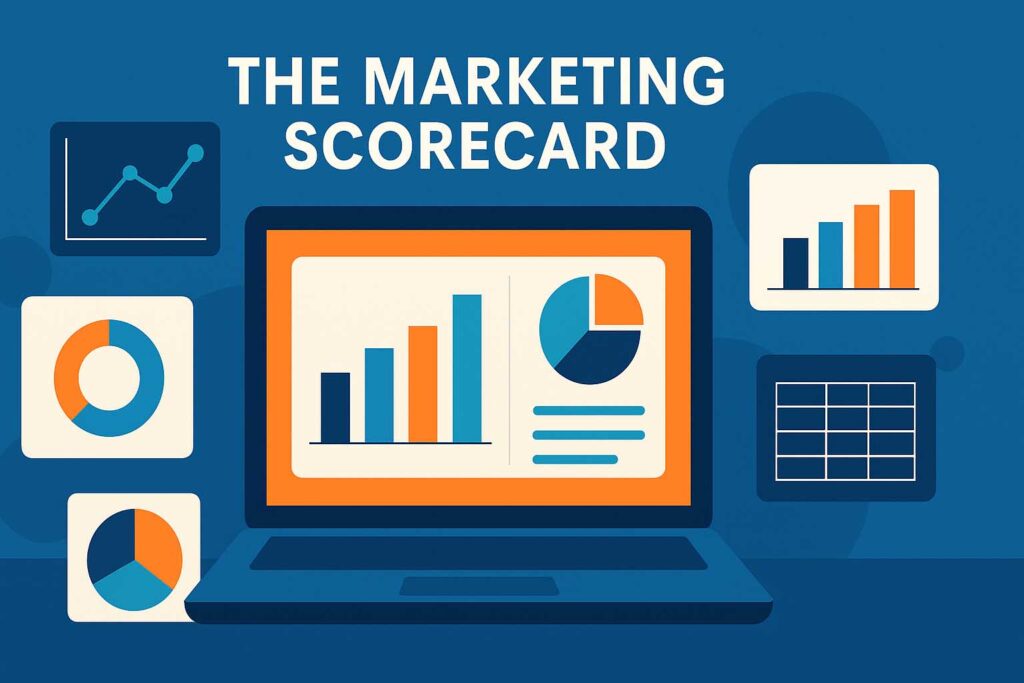First Things First: What Do We Mean by a Marketing Scorecard?
I’ve sat in more boardrooms than I care to count where the marketing report gets flicked through in silence. Slide after slide of clicks, impressions, bounce rates, then the CFO leans forward and asks: “Yes, but did we actually make more money?”
That’s the moment I explain what a scorecard really is.
A Marketing Scorecard is not a dashboard. It’s a stripped-back, decision-grade framework that links four essentials:
- brand demand (are people actively searching for you?),
- traffic quality (are they the right people?),
- pipeline health (are leads moving fast enough?),
- and revenue contribution (is marketing pulling its weight?).
The point isn’t to track everything; it’s to show the numbers that actually move the boardroom conversation, the ones that decide budgets, staffing, and future strategy.
If your marketing report doesn’t survive the CFO’s “so what?” test, it isn’t a scorecard.
Why This Topic Matters
Here’s the uncomfortable truth: most marketing reports are ignored. I’ve seen it happen with independents in Dorset right up to corporates in London. A team proudly shares a dashboard full of “engagement growth” and “time on site,” only for the finance director to ask the only question that matters: “Did revenue move?”
That silence in the room tells you why this topic matters.
A proper scorecard cuts through that noise. It doesn’t drown leaders in metrics; it connects the dots between marketing effort and commercial reality, pipeline velocity, brand demand, and contribution to revenue.
For independents, this is about proving ROI in plain English: “If I spend £2,000, I expect X new customers.”
For SMEs, it’s about focus, pulling sales, marketing, and product onto the same page so resources aren’t wasted.
For corporates, it’s survival. Without a decision-grade scorecard, marketing is dismissed as a cost centre while other departments win investment.
Put simply: if your board can’t see how marketing impacts revenue, marketing loses its seat at the table.
How We Got Here: From Dashboards to Distrust

To understand why scorecards are critical now, you have to see how we got here. Marketing reporting hasn’t always been this messy, it evolved in waves.
- 2000s – The Dashboard Boom
I still remember when Google Analytics landed. For marketers, it felt like magic: suddenly we could see traffic spikes in real time. But for boards, it quickly became a source of scepticism. They didn’t care that traffic was “up 20%.” They wanted to know if profit was up, and the dashboards rarely answered that. - 2010s – KPI Overload
Then came the flood. Every platform, Facebook, LinkedIn and AdWords brought its own metrics. Social teams spoke in engagement rates, SEO in rankings, PPC in CTRs. I watched execs glaze over during presentations. Too much noise, not enough clarity. What marketers saw as proof, boards saw as distraction. - 2020s – Decision Fatigue
Now we’re in the AI-driven, multi-channel era. Data is everywhere, customer journeys are fragmented, and executives are frankly overwhelmed. I’ve seen corporates in London and SMEs in Bournemouth react the same way: they no longer trust the marketing numbers in front of them.
That’s why the scorecard isn’t just another reporting tool. It’s a trust mechanism. It distils all the noise into a handful of numbers that the board can actually act on.
The Blind Spots That Sink Most Scorecards

Every business thinks they’re building a scorecard. Most are really just reshuffling dashboards. And I’ve seen the same blind spots crop up again and again.
- Numbers without thresholds.
I once sat through a presentation where a team proudly announced “traffic up 12%.” The board stared blankly. One director finally asked: “So… was that good or bad?” That’s the problem. Without targets, metrics are meaningless. Boards want context: “Traffic hit 90% of our pipeline goal.” - Relying only on lagging indicators.
Revenue reports are essential, but they’re too late for prevention. By the time revenue dips show up, the damage is already done. Leading signals like search demand or pipeline velocity give you a chance to act before it’s fatal. - Drowning in KPIs.
A Dorset SME once showed me a 64-metric “scorecard.” It was unreadable. If your board has more than 10 numbers to look at, you don’t have a scorecard, you have a distraction. - Metrics without owners.
I can’t stress this enough: if nobody owns a metric, it drifts. A scorecard is only as strong as the accountability behind it. Someone has to wake up every Monday knowing they’re responsible for moving that number.
These aren’t cosmetic errors. They’re the reason most dashboards fail to influence decisions. And until you face them, your “scorecard” won’t earn trust at the top table.
When Dashboards Fail: A UK E-Commerce Story
I worked with an e-commerce brand that dreaded board meetings. The marketing team would turn up with slide decks packed full of numbers: CTRs, engagement rates, time on site. Everything looked “positive,” at least on paper. But sales hadn’t moved in months. Every meeting turned into the same interrogation: “Where’s the revenue?”
The turning point came when we stripped everything back. No more drowning in 40-page decks. Instead, we rebuilt their reporting into a scorecard with four pillars: brand demand, findability, experience, and activation.
The next time they presented, the board didn’t argue about clicks or bounce rates. They asked something far more useful: “Which pillar do we invest more in?” That one shift unlocked additional budget within a single quarter. Not because the marketing suddenly changed, but because the story finally made sense at board level.
The lesson? Dashboards tell you what happened. A scorecard tells leaders what to do next.
Dashboards vs Scorecards: Spot the Difference
I often explain it this way: a dashboard is like your car’s instrument panel, useful for the driver, but meaningless to the passenger. The marketing team might love seeing CTRs, bounce rates, and impressions flash in real time. But when you’re in the boardroom, the finance director doesn’t want to know how fast the wheels are spinning, they want to know if the car is getting closer to its destination. That’s the scorecard.
Here’s how they really differ:
| Typical Dashboard | Boardroom-Ready Scorecard | |
| Focus | Activity | Outcomes |
| Metrics | Dozens (CTR, likes, bounce rate) | 6–10 tied to revenue or pipeline |
| Context | Raw numbers | Targets, thresholds, benchmarks |
| Timeframe | Lagging (last quarter) | Leading + lagging indicators |
| Audience | Marketing team | Executives, CFO, board |
This is where most teams go wrong: they bring dashboards to board meetings and wonder why credibility falls flat. Dashboards describe what’s happening. Scorecards decide what to do next.
Insider Knowledge: The Stuff Beginners Miss

Here’s what I’ve learned the hard way:
Pipeline velocity is the number sales directors actually watch. Not “how many leads came in,” but how fast they move through. I once worked with an SME in Dorset where the top of funnel looked fantastic, enquiries flying in. But when we checked velocity, deals were crawling at 45 days instead of 20. The pipeline looked busy but revenue was already doomed.
Brand demand is the canary in the coal mine. If searches for your company name start dropping, it’s an early warning. I’ve seen businesses ignore this until their sales cratered six months later. By then, fixing it was ten times harder.
And let’s clear this up: perfect attribution doesn’t exist. If you’re chasing a model that tells you exactly which click created which sale, you’re wasting cycles. The pros accept imperfection, blend models, run lift tests, and move on.
Finally, cadence matters more than content. A scorecard reviewed quarterly becomes wallpaper. Reviewed fortnightly at team level and monthly at board level, it becomes the drumbeat for decisions. Get the rhythm wrong, and even the best scorecard gathers dust.
Want clarity on your marketing impact?
Speak to our team at Digital Hype. We’ll help you cut through the noise and build scorecards that connect activity to revenue.
Get in TouchService-by-Budget
Independent Businesses (£1k–£2k per month)
- Simple Excel or Google Sheets scorecard.
- 3–4 core metrics tied to sales activity.
- Monthly review sessions.
SMEs (£3k–£7k per month)
- Integrated scorecard (GA4, CRM, social).
- 6–10 board-level metrics with owners.
- Fortnightly team reviews + monthly exec reviews.
Corporates (£10k+ per month)
- Enterprise scorecard pulling from multiple data layers.
- Governance models, attribution blending, data warehousing.
- Exec-ready presentations with CFO/CIO alignment.
The Scorecard Questions That Matter
Isn’t a scorecard overkill for a one-person business?
Not if you keep it simple. For independents, a scorecard can be as basic as a Google Sheet with three numbers: leads generated, conversion rate, and sales closed. The key isn’t the tool, it’s having a rhythm for reviewing those numbers every month.
Can I build a scorecard without expensive software?
Yes. Many independents and SMEs start with free or low-cost tools like Google Sheets, GA4, or a CRM export. The sophistication of the tool should match the size of your operation, corporates may need enterprise data layers, but independents don’t.
How does a scorecard actually help prove ROI?
Because it links marketing to outcomes the board cares about: pipeline velocity, brand demand, and revenue contribution. If marketing is only showing CTRs and impressions, ROI remains a guess. A scorecard makes the commercial link visible.
What if my MD or CFO doesn’t care about marketing metrics?
That’s exactly why you need a scorecard. Boards don’t care about “marketing numbers”, they care about business outcomes. A scorecard reframes marketing in that language, building trust and credibility.
How many metrics should be on a scorecard?
No more than 10 at board level. Any more, and attention fragments. Marketing teams can track dozens in the background, but the boardroom only needs the numbers tied to growth decisions.
How do we balance short-term wins with long-term brand building?
Reserve space on the scorecard for both. For example, include campaign ROI (short-term) and brand search volume (long-term). If you only track one, the other gets neglected, and both are vital.
How do corporates avoid turning scorecards into bureaucracy?
By keeping autonomy at the squad/team level but rolling up into one executive view. The role of governance is to protect cadence (monthly reviews), not to bury teams in extra reporting.
Can a scorecard handle attribution across multiple channels?
It won’t give you perfect attribution, that doesn’t exist. What it will do is blend models (e.g., position-based plus lift tests) to show directional clarity. Boards don’t need perfection; they need enough confidence to make investment calls.
How often should a board see the scorecard?
For corporates: monthly at board level, fortnightly at team level. For SMEs and independents: monthly is enough. The cadence matters more than the tool, too infrequent, and issues go unnoticed; too frequent, and it becomes noise.
How do agencies work with scorecards?
The best agencies integrate into the client’s scorecard rhythm, attending backlog reviews, committing to specific numbers, and presenting outcomes, not just activity. Agencies that resist this usually reveal they’re more comfortable with vanity metrics.
What’s the cost difference by business size?
Independents: free or minimal (time + Google Sheets). SMEs: £3k–£7k/month for integrated reporting and facilitation. Corporates: £10k+ for enterprise scorecards with governance and data warehousing.
What happens if we don’t build one?
Marketing stays in the “activity” lane. Budgets get cut, trust erodes, and decisions are made without marketing at the table. The cost of not having a scorecard is losing influence when it matters most.
The Cost of Getting This Wrong
I’ve lost count of how many marketing teams have quietly bled budget because they couldn’t connect their work to revenue. It’s not that their campaigns failed, often the activity was solid. The failure was in translation: when the board asked, “What did this do for the business?” they had no answer beyond charts and percentages.
That’s why scorecards matter more than ever. They’re not reporting tools; they’re survival strategies. A dashboard may tell you marketing is busy. A scorecard proves marketing is valuable.
For independents, it’s the difference between persuading yourself and persuading investors. For SMEs, it’s how you stop being the “nice-to-have” department and start shaping growth strategy. And for corporates, it’s how you keep marketing from becoming a cost line that gets trimmed in the next budget cycle.
Here’s the hard truth: without a scorecard, marketing stays outside the decision-making room, fighting for scraps. With one, you’re in the conversation that decides the future of the business. And that is a position no marketing leader can afford to give up.
Ready to Make Marketing Count in the Boardroom?
Don’t let your marketing get dismissed as “just spend.” Our team works with independents, SMEs, and corporates across Bournemouth, Dorset, and UK-wide to build boardroom-ready scorecards that prove value.
Contact Us Today

